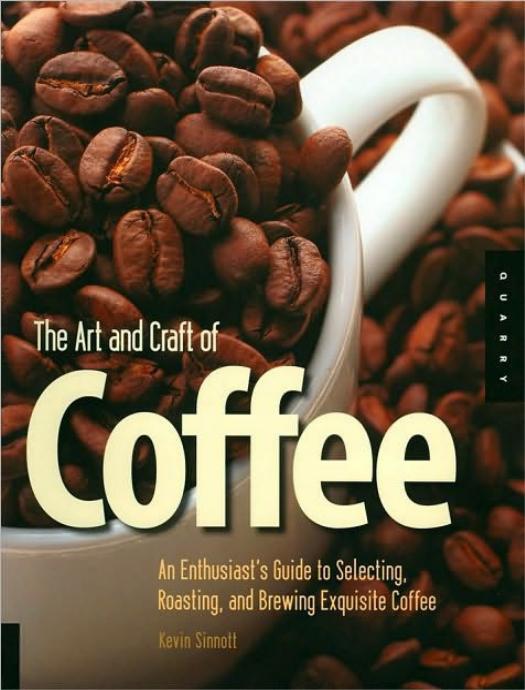The Art and Craft of Coffee: An Enthusiast's Guide to Selecting, Roasting, and Brewing Exquisite Coffee by Kevin Sinnott

Author:Kevin Sinnott [Sinnott, Kevin]
Language: eng
Format: mobi, epub, pdf
Tags: Coffee, Cooking, Coffee & Tea, Beverages, Coffee Brewing, General, Wine & Spirits, food
ISBN: 9781592535637
Google: 2nZsiYAftV4C
Amazon: 1592535631
Goodreads: 7914930
Publisher: Quarry Books
Published: 2010-06-01T10:00:00+00:00
Warning: Most novices grind too fine. Start out grinding coarser than you think you’ll need. Then move a notch at a time finer until you reach the perfect grind and taste.
Pulverized Grind
With this grind, coffee is as fine as flour. If you dip your fingers into Turkish ground coffee, which is typically pulverized, your fingers should come out coated with dust. Blade grinders could likely produce this grind, but you would lose aroma and flavor due to overheating. Consumer burr grinders rarely have the calibration to grind this fine.
A friend who’s an archaeology professor uses a mortar and pestle, which seems to work extraordinarily well. It can crush the beans to the required fineness without heating them up. For Turkish coffee devotees, get a mortar and pestle, which is easy to use and maintain and costs far less than the other less-likely-to-be-successful alternatives. Average particle size is 100 microns.
Espresso Grind
We devote an entire chapter of this book to Espresso, so we’ll only touch on it here to present it as a grinding option and so you can see where in the fine-coarse continuum it falls. For more information about espresso, see chapter 6, “Espresso,” which begins on page 127. Average particle size is 200 microns.
Fine/Vacuum Grind
This fine grind should almost, but not quite, be a powder. If you stick your finger in and pull it out, most of the coffee should not cling. It is designed for vacuum coffee brewers (discussed in chapter 5, “Brewing,” page 89) that typically feature three-minute extraction times. It also is appropriate for manual one-cup Melitta-style V-shaped cone filters or half batches of larger brewers that feature a three- to four-minute contact time (also see chapter 5). Average particle size is 500 microns.
Drip Grind
Most modern canned coffees use this grind, which is coarser than vacuum. It contains no powder and is designed for four- to six-minute contact times. It is coarser than table salt, but it should feature table salt’s pouring ability. The grounds should not cling together. Any brewing method that uses gravity—such as with drip coffee—needs grounds coarse enough to allow the water to pass easily through under its own weight. Average particle size is 500 microns and larger.
Automatic Drip Grind
These grounds start to resemble kosher salt. Designed for use in metal filter baskets typically found in electric percolators, this grind stands up to six- to eight-minute contact time. Therefore, it can work for any brewer that takes longer than six minutes to brew or any method in which a metal filter containing holes allows small particles through and into your cup, such as a press pot (most often used with a three- to four-minute contact time, regardless of grind) or flip drip maker (see chapter 5, “Brewing”).
If your automatic drip maker uses an underpowered electric heating element and chugs away brewing coffee for ten or twelve minutes, use coarse grounds. This helps the ground coffee endure the “long hot summer” of prolonged contact time. Bunn’s flat-bottomed automatic drip uses an uncommonly brief
Download
The Art and Craft of Coffee: An Enthusiast's Guide to Selecting, Roasting, and Brewing Exquisite Coffee by Kevin Sinnott.epub
The Art and Craft of Coffee: An Enthusiast's Guide to Selecting, Roasting, and Brewing Exquisite Coffee by Kevin Sinnott.pdf
This site does not store any files on its server. We only index and link to content provided by other sites. Please contact the content providers to delete copyright contents if any and email us, we'll remove relevant links or contents immediately.
| Beer | Cocktails & Mixed Drinks |
| Coffee & Tea | Homebrewing, Distilling & Wine Making |
| Juices & Smoothies | Wine & Spirits |
101 Whiskies to Try Before You Die by Ian Buxton(44787)
World's Best Whiskies by Dominic Roskrow(44730)
Whiskies Galore by Ian Buxton(41864)
Craft Beer for the Homebrewer by Michael Agnew(18140)
Right Here, Right Now by Georgia Beers(4122)
Not a Diet Book by James Smith(3335)
Water by Ian Miller(3126)
The Coffee Dictionary by Maxwell Colonna-Dashwood(3062)
Kitchen confidential by Anthony Bourdain(3006)
Coffee for One by KJ Fallon(2559)
Smuggler's Cove: Exotic Cocktails, Rum, and the Cult of Tiki by Martin Cate & Rebecca Cate(2468)
Superfood Smoothie Bowls: Delicious, Satisfying, Protein-Packed Blends that Boost Energy and Burn Fat by Chace Daniella(2387)
Talking as Fast as I Can by Lauren Graham(2379)
Beer is proof God loves us by Charles W. Bamforth(2368)
Bourbon: A Savor the South Cookbook by Kathleen Purvis(2244)
A Short History of Drunkenness by Forsyth Mark(2232)
Eat With Intention by Cassandra Bodzak(2154)
Cocktails for the Holidays by Editors of Imbibe magazine(2079)
Colombia Travel Guide by Lonely Planet(2060)
